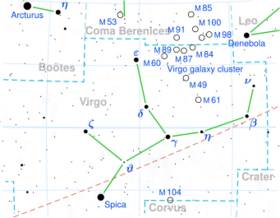Astronomy:Pi Virginis
From HandWiki
Short description: Binary star in the constellation Virgo
| Observation data Equinox J2000.0]] (ICRS) | |
|---|---|
| Constellation | Virgo |
| Right ascension | 12h 00m 52.39042s[1] |
| Declination | +06° 36′ 51.5571″[1] |
| Apparent magnitude (V) | 4.64[2] |
| Characteristics | |
| Spectral type | A5 V[3] |
| U−B color index | +0.12[2] |
| B−V color index | +0.12[2] |
| Astrometry | |
| Radial velocity (Rv) | −10.4[4] km/s |
| Proper motion (μ) | RA: +0.26[1] mas/yr Dec.: −30.10[1] mas/yr |
| Parallax (π) | 8.49 ± 0.39[1] mas |
| Distance | 380 ± 20 ly (118 ± 5 pc) |
| Absolute magnitude (MV) | −0.70[5] |
| Orbit[6] | |
| Primary | π Virginis A |
| Companion | π Virginis B |
| Period (P) | 282.69 days |
| Semi-major axis (a) | 3.55 mas |
| Eccentricity (e) | 0.265 |
| Inclination (i) | 62.71° |
| Longitude of the node (Ω) | 149.34° |
| Periastron epoch (T) | 2448281.3906 |
| Argument of periastron (ω) (secondary) | 312° |
| Semi-amplitude (K1) (primary) | 26.20[7] km/s |
| Details | |
| π Vir A | |
| Mass | 2.2[7] M☉ |
| Radius | 1.5[8] R☉ |
| Surface gravity (log g) | 3.51[9] cgs |
| Temperature | 8,000[9] K |
| Rotational velocity (v sin i) | 71[3] km/s |
| Other designations | |
| Database references | |
| SIMBAD | data |
Pi Virginis (π Vir, π Virginis) is a binary star in the zodiac constellation of Virgo. It is visible to the naked eye with an apparent visual magnitude of 4.64.[2] The distance to this star, based upon parallax measurements,[1] is roughly 380 light years.
This is a spectroscopic binary system with a stellar classification of A5V. They have an orbital period of 283 days with an eccentricity of 0.27.[7] The mass ratio of the two stars is about 0.47, with the primary having an estimated mass of around 2.2 times that of the Sun. The primary is a cool metallic-lined Am star.[9]
References
- ↑ 1.0 1.1 1.2 1.3 1.4 1.5 van Leeuwen, F. (November 2007), "Validation of the new Hipparcos reduction", Astronomy and Astrophysics 474 (2): 653–664, doi:10.1051/0004-6361:20078357, Bibcode: 2007A&A...474..653V.
- ↑ 2.0 2.1 2.2 2.3 Mermilliod, J.-C. (1986), "Compilation of Eggen's UBV data, transformed to UBV (unpublished)", Catalogue of Eggen's UBV Data, Bibcode: 1986EgUBV........0M.
- ↑ 3.0 3.1 Royer, F. et al. (February 2007), "Rotational velocities of A-type stars. III. Velocity distributions", Astronomy and Astrophysics 463 (2): 671–682, doi:10.1051/0004-6361:20065224, Bibcode: 2007A&A...463..671R.
- ↑ Evans, D. S. (June 20–24, 1966), Batten, Alan Henry; Heard, John Frederick, eds., "The Revision of the General Catalogue of Radial Velocities", Determination of Radial Velocities and their Applications, Proceedings from IAU Symposium no. 30 (University of Toronto: International Astronomical Union) 30: pp. 57, Bibcode: 1967IAUS...30...57E.
- ↑ Anderson, E.; Francis, Ch. (2012), "XHIP: An extended hipparcos compilation", Astronomy Letters 38 (5): 331, doi:10.1134/S1063773712050015, Bibcode: 2012AstL...38..331A.
- ↑ ESA (1997). "The Hipparcos and Tycho Catalogues". VizieR On-line Data Catalog. Bibcode: 1997yCat.1239....0E.
- ↑ 7.0 7.1 7.2 Ducati, J. R. et al. (January 2011), "The mass ratio and initial mass functions in spectroscopic binaries", Astronomy and Astrophysics 525: 9, doi:10.1051/0004-6361/200913895, A26, Bibcode: 2011A&A...525A..26D, http://www.lume.ufrgs.br/bitstream/10183/99264/1/000821103.pdf.
- ↑ Pasinetti Fracassini, L. E. et al. (February 2001), "Catalogue of Apparent Diameters and Absolute Radii of Stars (CADARS) - Third edition - Comments and statistics", Astronomy and Astrophysics 367 (2): 521–524, doi:10.1051/0004-6361:20000451, Bibcode: 2001A&A...367..521P.
- ↑ 9.0 9.1 9.2 Paunzen, E. et al. (February 2013), "A photometric study of chemically peculiar stars with the STEREO satellites - II. Non-magnetic chemically peculiar stars", Monthly Notices of the Royal Astronomical Society 429 (1): 119–125, doi:10.1093/mnras/sts318, Bibcode: 2013MNRAS.429..119P.
- ↑ "pi. Vir -- Spectroscopic binary", SIMBAD Astronomical Database (Centre de Données astronomiques de Strasbourg), http://simbad.u-strasbg.fr/simbad/sim-id?Ident=pi+vir, retrieved 2016-09-16.
 |


